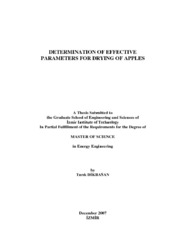Please use this identifier to cite or link to this item:
https://hdl.handle.net/11147/3917Full metadata record
| DC Field | Value | Language |
|---|---|---|
| dc.contributor.advisor | Gökçen Akkurt, Gülden | - |
| dc.contributor.author | Dikbasan, Tarık | - |
| dc.date.accessioned | 2014-07-22T13:52:40Z | - |
| dc.date.available | 2014-07-22T13:52:40Z | - |
| dc.date.issued | 2007 | - |
| dc.identifier.uri | http://hdl.handle.net/11147/3917 | - |
| dc.description | Thesis (Master)--Izmir Institute of Technology, Energy Engineering, Izmir, 2007 | en_US |
| dc.description | Includes bibliographical references (leaves: 66-69) | en_US |
| dc.description | Text in English; Abstract: Turkish and English | en_US |
| dc.description | xiii, 78 leaves | en_US |
| dc.description.abstract | Drying is one of the oldest methods for the preservation of agricultural products such as fruits and vegetables. Apple has a significant share in fruit production both in the World and in Turkey. It is also an important raw material for many food products.Temperature, velocity and relative humidity of drying air are important parameters for hot air drying process. To determine the drying kinetic of agricultural products, drying and drying rate curves should be plotted.Experiments are conducted in a tunnel dryer using cubic shaped (10x10x10mm) red delicious (Malus Domestica) apple for various drying air temperature (40.1-65.3oC), velocity (1.1, 1.4, 1.9, 2.3 and 2.5 m/s) and relative humidity (4.6-20.5%) values. The temperature and relative humidity are measured and recorded every 1 min. at fan inlet, upstream and downstream of the tray, the velocity is measured only at the tunnel exit. The measured data is used to obtain drying and drying rate curves. The curves indicate that drying process takes place in the falling rate period except very short unsteady-state initial and constant rate periods. Thus, effective diffusion coefficients are calculated using the data collected during the falling rate period and the experimental data are fitted to fourteen thin layer drying models which are found in the literature. Rehydration time and colour are used as parameters for the dried apple quality.The effective diffusion coefficients are obtained within the range of 0.486x10-9 -5.63x10-9 m2/s Regarding with drying time, rehydration time and colour data, the best results are obtained at 2.5 m/s velocity, 20.5% relative humidity and a temperature range of 53.5-65.3oC under experimental conditions. Midilli and Kucuk model is the best fitted model with a minimum R2 of 0.9991 and a maximum RMSE of 0.0087976. | en_US |
| dc.language.iso | en | en_US |
| dc.publisher | Izmir Institute of Technology | en_US |
| dc.rights | info:eu-repo/semantics/openAccess | en_US |
| dc.subject.lcc | TP371.5 D5757 2008 | en |
| dc.subject.lcsh | Food--Drying | en |
| dc.subject.lcsh | Fruit--Drying | en |
| dc.subject.lcsh | Drying--Apparatus--Food | en |
| dc.title | Determination of Effective Parameters for Drying of Apples | en_US |
| dc.type | Master Thesis | en_US |
| dc.institutionauthor | Dikbasan, Tarık | - |
| dc.department | Thesis (Master)--İzmir Institute of Technology, Energy Systems Engineering | en_US |
| dc.relation.publicationcategory | Tez | en_US |
| dc.identifier.wosquality | N/A | - |
| dc.identifier.scopusquality | N/A | - |
| item.openairecristype | http://purl.org/coar/resource_type/c_18cf | - |
| item.languageiso639-1 | en | - |
| item.openairetype | Master Thesis | - |
| item.grantfulltext | open | - |
| item.fulltext | With Fulltext | - |
| item.cerifentitytype | Publications | - |
| Appears in Collections: | Master Degree / Yüksek Lisans Tezleri | |
Files in This Item:
| File | Description | Size | Format | |
|---|---|---|---|---|
| T000743.pdf | MasterThesis | 1.15 MB | Adobe PDF |  View/Open |
CORE Recommender
Page view(s)
370
checked on Mar 31, 2025
Download(s)
750
checked on Mar 31, 2025
Google ScholarTM
Check
Items in GCRIS Repository are protected by copyright, with all rights reserved, unless otherwise indicated.